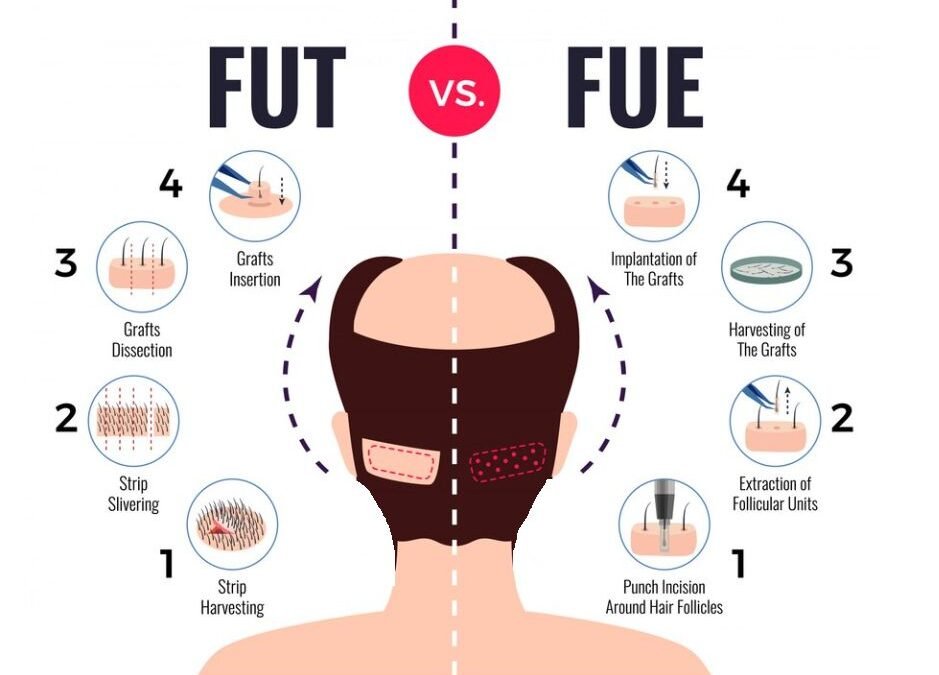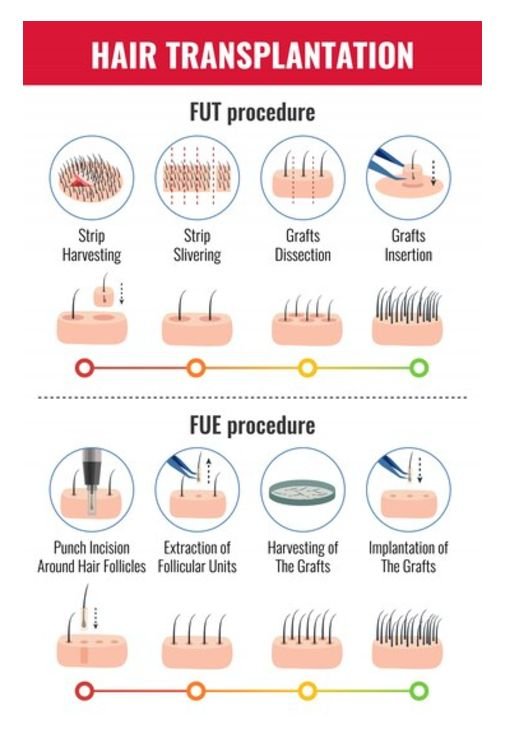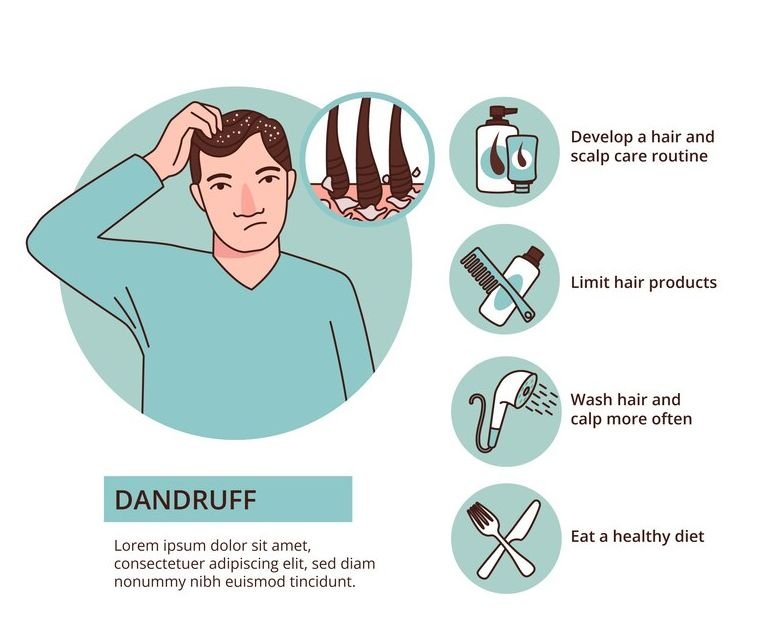FUE vs FUT: Which Hair Transplant Method Is Right for You?
When considering a hair transplant, the decision between Follicular Unit Extraction (FUE) and Follicular Unit Transplantation (FUT) can feel overwhelming. Both techniques are highly effective for restoring hair, but they differ in terms of procedure, recovery, and cost. Understanding these differences can help you make an informed decision about which method suits your needs.


What is FUE (Follicular Unit Extraction)?
FUE involves the extraction of individual hair follicles from a donor area on the scalp, typically the back of the head, where hair growth is most robust. These follicles are then transplanted to areas where hair loss has occurred. FUE is a less invasive technique compared to FUT, as it doesn’t involve removing strips of skin from the scalp. Instead, each follicle is harvested using a small, circular punch tool, which minimizes scarring.
This method has grown in popularity due to its minimal scarring and quicker recovery time. According to the International Society of Hair Restoration Surgery (ISHRS), 75.4% of men worldwide chose FUE for their hair transplant procedure in 2022 [1].


What is FUT (Follicular Unit Transplantation)?
FUT, also known as the “strip method,” involves the surgical removal of a strip of scalp from the donor area. The strip is then divided into smaller sections containing individual hair follicles, which are implanted into the thinning or balding areas. Although FUT can yield a higher number of grafts in a single session, it is more invasive and leaves a linear scar where the strip was removed.
While FUT has been the traditional method for hair restoration, it is less commonly used today due to the scarring and longer recovery time compared to FUE.
Key Differences Between FUE and FUT
Both FUE and FUT offer excellent results, but they vary in several important aspects:
- Cost: FUE is typically more affordable than FUT, despite being a longer and more time-consuming procedure. The reason for this cost difference is that FUE requires a more meticulous approach to extracting and implanting individual follicles, making it a more cost-effective procedure overall [2].
- Invasiveness: FUE is less invasive because it doesn’t require the removal of a scalp strip, leading to reduced pain and a shorter recovery time. Conversely, FUT involves a more invasive procedure with a longer recovery period due to the removal of the scalp strip.
- Recovery Time: Recovery from FUE tends to be quicker, with most patients returning to normal activities within a few days. In contrast, FUT can require a longer healing time because of the linear scar left by the strip of scalp that’s removed [3][4].
- Scarring: One of the key benefits of FUE is that it leaves minimal scarring, often small, dot-like marks that are hardly visible. On the other hand, FUT results in a linear scar along the donor area, which may be noticeable, especially if the hair is shaved short.

Which Procedure Is More Painful?
Both procedures involve a local anaesthetic, so pain during the transplant itself is minimal. However, FUE is generally considered less painful during recovery since it’s less invasive. FUT, while it may cause more discomfort initially due to the strip removal, can also be managed with pain medication. In general, the discomfort from FUT tends to last a bit longer than that from FUE [5].
Which Procedure Looks More Realistic?
Both FUE and FUT can produce natural-looking results, as both methods involve transplanting individual follicular units. However, FUE tends to offer more flexibility in terms of the angle and direction of the hair placement, which may contribute to a slightly more natural appearance. Both techniques are designed to mimic the natural growth pattern of hair, and the final results are nearly indistinguishable from natural hair when performed by a skilled surgeon [4][6].
Is There a Difference in Success Rates?
Both FUE and FUT offer high success rates, with most patients experiencing significant hair regrowth after the procedure. The success largely depends on the surgeon’s skill, the quality of the donor hair, and the post-operative care. While FUE is generally less invasive, FUT may be better suited for patients needing a larger number of grafts in a single session [6][7].
Which Hair Transplant Method Is Right for You?
The right choice between FUE and FUT depends on several factors, including your hair loss pattern, desired results, and personal preferences regarding recovery time and scarring. FUE is ideal for those seeking minimal scarring and a faster recovery, while FUT may be preferable for patients requiring a higher number of grafts in one session or those who are not concerned with a linear scar.
At Cure & Travel, based in London, UK, we specialise in providing consultations for hair transplant procedures. We can help guide you through the process, ensuring that you make an informed decision that aligns with your goals for hair restoration [8].
Book a Consultation
If you’re considering a hair transplant, the first step is to book a consultation. At Cure & Travel, we connect you with top clinics in Istanbul, Turkey, where advanced FUE and FUT procedures are available. Our team is here to help you choose the best method for your needs and guide you through the process every step of the way.

References
- International Society of Hair Restoration Surgery (ISHRS). Practice Census, 2022.
- HRBR Ireland. Hair Transplantation Methods Explained. 2024.
- Eugenix Hair Sciences. Comparing FUE and FUT: What You Need to Know. 2024.
- Este Medical Group. FUE vs FUT: Key Differences and Considerations. 2024.
- Zantman Clinic Netherlands. Pain Management in Hair Transplants: FUE vs FUT. 2024.
- Harley Street Hair Transplant Clinic. Hair Transplant Success Rates: FUE vs FUT. 2024.
- Dr Cinik Hair Transplant Clinic. Choosing Between FUE and FUT for Optimal Results. 2024.
- Cure & Travel. Connecting You with the Best Hair Transplant Clinics in Istanbul. 2024.
Blog
Alcohol and Hair Loss: Unveiling the Connection
Alcohol and Hair Loss: Unveiling the LinkHair loss is a widespread issue that affects millions of people globally, causing significant emotional and psychological distress. While genetic predisposition, hormonal changes, and medical conditions are well-established...
Can Red Light Therapy Reverse Hair Loss? A Scientific Perspective
Can Red Light Therapy Reverse Hair Loss? A Scientific PerspectiveHair loss is a widespread concern, affecting individuals across genders and age groups. With advancements in non-invasive treatments, red light therapy (RLT), also known as low-level laser therapy...
Your Needs, Our Solutions: Addressing Hair Loss with Cure & Travel
Your Needs, Our Solutions: Addressing Hair Loss with Cure & Travel Hair loss can be a distressing experience for many people, whether it's due to environmental factors, lifestyle choices, or genetics. At Cure & Travel, based in London, we understand the...







